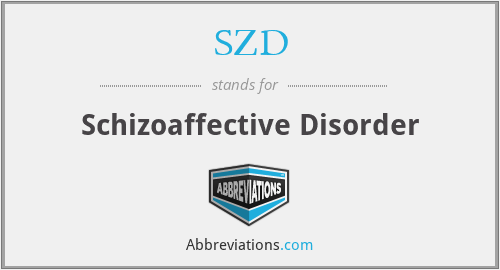What does SZD mean in Psychiatry?
This page is about the meanings of the acronym/abbreviation/shorthand SZD in the Medical field in general and in the Psychiatry terminology in particular.
Schizoaffective Disorder
Submitted by JokerGem on January 26, 2023
Translation
Find a translation for Schizoaffective Disorder in other languages:
Select another language:
- - Select -
- 简体中文 (Chinese - Simplified)
- 繁體中文 (Chinese - Traditional)
- Español (Spanish)
- Esperanto (Esperanto)
- 日本語 (Japanese)
- Português (Portuguese)
- Deutsch (German)
- العربية (Arabic)
- Français (French)
- Русский (Russian)
- ಕನ್ನಡ (Kannada)
- 한국어 (Korean)
- עברית (Hebrew)
- Gaeilge (Irish)
- Українська (Ukrainian)
- اردو (Urdu)
- Magyar (Hungarian)
- मानक हिन्दी (Hindi)
- Indonesia (Indonesian)
- Italiano (Italian)
- தமிழ் (Tamil)
- Türkçe (Turkish)
- తెలుగు (Telugu)
- ภาษาไทย (Thai)
- Tiếng Việt (Vietnamese)
- Čeština (Czech)
- Polski (Polish)
- Bahasa Indonesia (Indonesian)
- Românește (Romanian)
- Nederlands (Dutch)
- Ελληνικά (Greek)
- Latinum (Latin)
- Svenska (Swedish)
- Dansk (Danish)
- Suomi (Finnish)
- فارسی (Persian)
- ייִדיש (Yiddish)
- հայերեն (Armenian)
- Norsk (Norwegian)
- English (English)
Definition
What does SZD mean?
- Schizoaffective disorder
- Schizoaffective disorder (SZA, SZD or SAD) is a mental disorder characterized by abnormal thought processes and an unstable mood. The diagnosis is made when the person has symptoms of both schizophrenia (usually psychosis) and a mood disorder—either bipolar disorder or depression—but does not meet the diagnostic criteria for schizophrenia or a mood disorder individually. The main criterion for the schizoaffective disorder diagnosis is the presence of psychotic symptoms for at least two weeks without any mood symptoms present. Schizoaffective disorder can often be misdiagnosed when the correct diagnosis may be psychotic depression, psychotic bipolar disorder, schizophreniform disorder, or schizophrenia. It is imperative for providers to accurately diagnose patients, as treatment and prognosis differs greatly for each of these diagnoses.There are two types of schizoaffective disorder: the bipolar type, which is distinguished by symptoms of mania, hypomania, or mixed episode; and the depressive type, which is distinguished by symptoms of depression only. Common symptoms of the disorder include hallucinations, delusions, and disorganized speech and thinking. Auditory hallucinations, or "hearing voices," are most common. The onset of symptoms usually begins in young adulthood. Genetics (researched in the field of genomics); problems with neural circuits; chronic early, and chronic or short-term current environmental stress appear to be important causal factors. No single isolated organic cause has been found, but extensive evidence exists for abnormalities in the metabolism of tetrahydrobiopterin (BH4), dopamine, and glutamic acid in people with schizophrenia, psychotic mood disorders, and schizoaffective disorder. People with schizoaffective disorder are likely to have co-occurring conditions, including anxiety disorders and substance use disorders. The mainstay of current treatment is antipsychotic medication combined with mood stabilizer medication or antidepressant medication, or both. There is growing concern by some researchers that antidepressants may increase psychosis, mania, and long-term mood episode cycling in the disorder. When there is risk to self or others, usually early in treatment, hospitalization may be necessary. Psychiatric rehabilitation, psychotherapy, and vocational rehabilitation are very important for recovery of higher psychosocial function. As a group, people with schizoaffective disorder that were diagnosed using DSM-IV and ICD-10 criteria (which have since been updated) have a better outcome, but have variable individual psychosocial functional outcomes compared to people with mood disorders, from worse to the same. Outcomes for people with DSM-5 diagnosed schizoaffective disorder depend on data from prospective cohort studies, which have not been completed yet. The DSM-5 diagnosis was updated because DSM-IV criteria resulted in overuse of the diagnosis; that is, DSM-IV criteria led to many patients being misdiagnosed with the disorder. DSM-IV prevalence estimates were less than one percent of the population, in the range of 0.5–0.8 percent; newer DSM-5 prevalence estimates are not yet available.
Embed
Citation
Use the citation below to add this abbreviation to your bibliography:
Style:MLAChicagoAPA
"SZD." Abbreviations.com. STANDS4 LLC, 2024. Web. 10 Nov. 2024. <https://www.abbreviations.com/term/2664747>.



Discuss this SZD abbreviation with the community:
Report Comment
We're doing our best to make sure our content is useful, accurate and safe.
If by any chance you spot an inappropriate comment while navigating through our website please use this form to let us know, and we'll take care of it shortly.
Attachment
You need to be logged in to favorite.
Log In